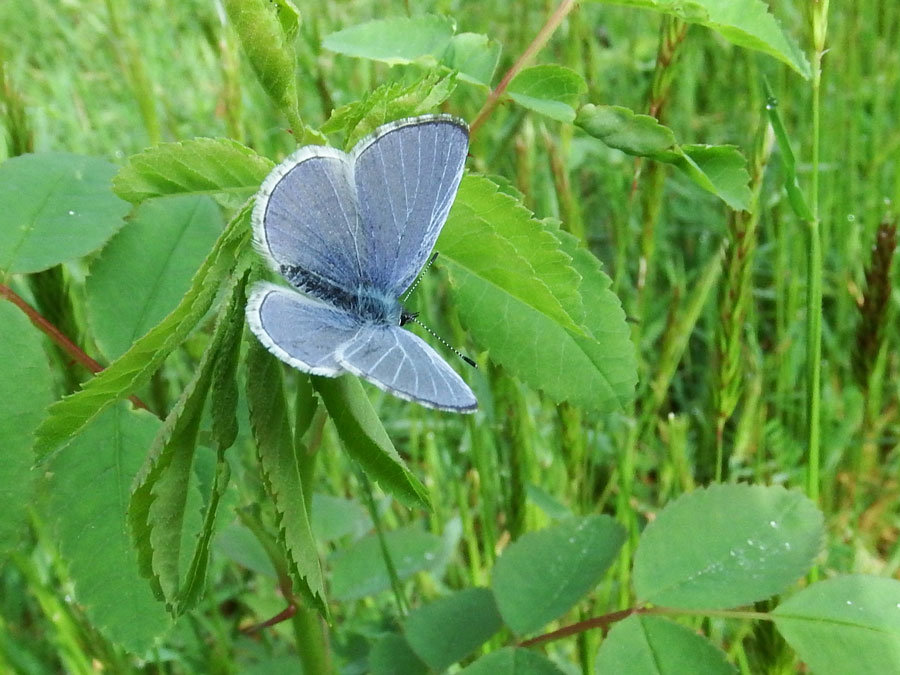
On the first day of spring over 60 degrees, I find a currant decked out with pink pendant blooms. It radiates a fragrance of heat, sweat and pollen. A constant buzz surrounds it, every bee and fly for miles having come to get a piece of the action. Then, among the blunt buzzing bodies, I see baby blue wings drift open and closed. A butterfly no bigger than a guitar pick tests a flower. In this madhouse of odor, such grace is mystical. It is the first butterfly I have seen this year. When it startles and tumbles into flight, it looks just like Robert Frost described it: a “sky-flake” in motion.
It is an echo azure, one of our earliest flyers. There are several species of “blues” that live around Puget Sound, and each tells a different story about adaptability. The echo azure stands out as a generalist. Its caterpillars munch on the developing flowers and berries of salal, huckleberry, cherry, madrona, violets and others. Adults nectar at all of those plants and more and use mud puddles and dung for nutrients. Echo azures have two full generations per year, and from year to year it might choose a different host plant depending on which has the heaviest flower and fruit sets.
Compare that with a nearly identical butterfly that cannot be found on the Key Peninsula any longer — if it ever could. The Puget blue depends solely upon lupines, especially a Puget Sound prairie species called sickle-keeled lupine that thrives alongside camas in traditionally managed prairies. Such a specialist can be just as successful as a generalist. Yet a century of agriculture, landscaping, development, fire suppression and the spread of plants like Scotch broom, has reduced the Puget blue’s range to less than a dozen isolated populations.
Incidentally, traditionally managed prairies tend to have far more species of butterfly than the damp patchwork of forest and landscaping that covers the Key Peninsula. I do wonder if we once had such prairies here.
Bird Hearing vs. Dog Hearing
Q: Do birds hear as well as dogs? — Violet Bruemmer, Vaughn
A: That’s a hard question to answer! Basically yes, birds do hear as well as dogs — but they hear differently.
Let’s start with our own hearing. We hear noises in a wide range of frequencies, from very low earthquake noises to moderately high whistles. But our best hearing is in the middle, in the range of human voices. Makes sense, right?
Birds and dogs hear much of the same range, but their best hearing is tuned to different things. Dogs hear far better than us in high frequencies, and they can hear noises far too high for our own ears. For birds, it depends. Different types of birds are tuned to different things. Many hear low noises better than we can. Some, like owls, have far more sensitive hearing overall. Birds use sound for many reasons and have adapted accordingly.
A cool thing about birds is that the nerve endings in their inner ears, which serve to turn vibrations into information, continuously regenerate. Ours don’t. So while we and our dogs lose our hearing as we get old, a bird’s hearing is forever young.
Beep … Beep … Beep …
A reader tells me she has been hearing this clear, high note repeated near her house. At first she thought it was an alarm, or the dying battery of a game camera, or a crashed alien spaceship. But when she paid closer attention, she found that the hidden source of the sound was moving up and down her street. It seemed to be in the trees.
She got a recording with her cell phone, and I could confirm; it was a northern pygmy-owl.
This terribly cute pompom of an owl is a rarity in the Puget Sound lowlands. Even in their mountain haunts they are elusive and difficult to spot. Unlike most owls, they are active during the day, sneaking around treetops to keep an eye out for passing meals. They like to hunt for songbirds. They also eat small mammals and large insects, as well as the occasional lizard.
Amazingly, this reader’s pygmy-owl is not the only one on the Key Peninsula this spring. Birders have recorded one at Penrose Point State Park, and here on our farm near Glen Cove I have had to drop my pruning shears several times to run into the forest, having heard that slow sequence of crystal beeps. Never have I heard pygmy-owls here before. In fact, there are only three prior records ever on the peninsula.
A miniature invasion of miniature owls! Does it have to do with heavy snowfall in the mountains? An abundance of certain local prey? In springtime, long sequences of daytime beeps are likely to be coming from male owls advertising territories. A territory can be as big as a square mile. Keep your ears open. Could we possibly have lowland nesting pygmy-owls this year? On the peninsula? It’s incredible to imagine.
UNDERWRITTEN BY THE FUND FOR NONPROFIT NEWS (NEWSMATCH) AT THE MIAMI FOUNDATION, THE ANGEL GUILD, ADVERTISERS, DONORS AND PEOPLE WHO SUPPORT INDEPENDENT, NONPROFIT LOCAL NEWS